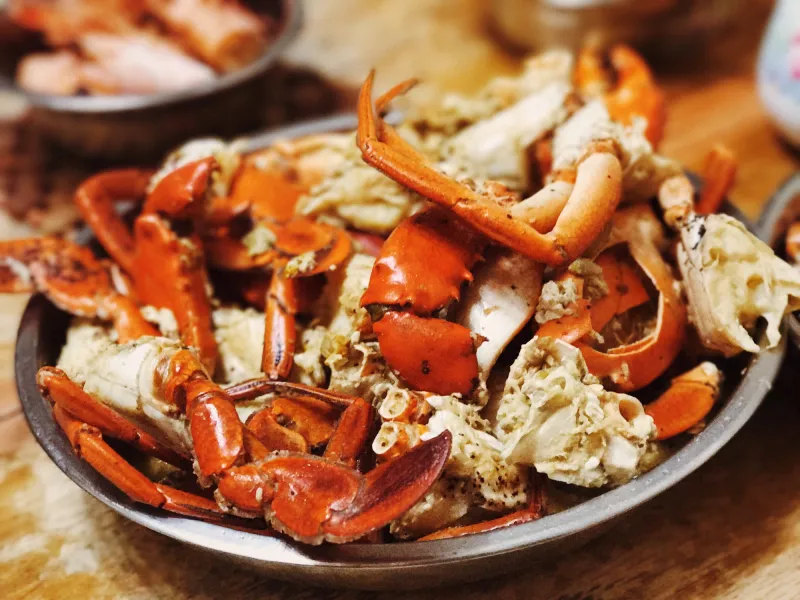
Chamberlains of London – Prepare crab for delicious dishes by following the right methods to bring out its natural sweetness and flavor. Crab is a versatile seafood, loved for its tender, delicate meat. Whether you’re cooking a crab feast, making crab cakes, or adding it to soups, there are several ways to prepare it. Understanding the best techniques can enhance the crab’s taste and texture, making any meal unforgettable.
Before preparing crab, it’s important to choose the right type of crab. Common varieties include blue crabs, snow crabs, and king crabs. Each type has a distinct flavor and texture, with snow and king crabs being meatier and more luxurious, while blue crabs are sweeter and more delicate. When buying crabs, ensure they are fresh. Live crabs should be active, and cooked crabs should smell fresh without a strong fishy odor.
“Read about: The Rise of Reynold Poernomo: From Contestant to Celebrity Chef”
Properly cleaning the crab is essential for any dish. Start by rinsing the crab under cold water to remove dirt and debris. If using live crabs, first humanely kill them by placing them in the freezer for about 20 minutes before cooking. Once they are dead, turn the crab over and remove the apron (the small flap at the bottom).
Next, gently pry open the shell and remove the gills, which are the feathery structures on either side of the crab. You should also remove the internal organs and the stomach sac. The remaining body is full of tender meat, perfect for dishes. The claws and legs also contain delicious crab meat.
Steaming is one of the most popular and healthiest ways to cook crab. It preserves the flavor and texture while ensuring the meat stays juicy. To steam crab, fill a large pot with about an inch of water and bring it to a boil. Add a steamer basket or a colander to the pot, ensuring the water doesn’t touch the crab. Place the crab in the basket, cover the pot, and steam for 15–20 minutes, depending on the size of the crab.
When the shells turn a bright orange or red, the crab is done. Steaming keeps the crab moist and tender, making it ideal for serving with melted butter or seasoning.
Boiling is another simple method to prepare crab, and it’s perfect for making crab legs or whole crabs. Fill a large pot with water, ensuring there’s enough room for the crabs. Bring the water to a boil, adding salt and any seasonings like bay leaves, peppercorns, or lemon slices. Once the water is boiling, add the crab and cover the pot.
Boil the crabs for 10–15 minutes, depending on their size. As with steaming, the shells should turn a vibrant red when done. For extra flavor, add seasoning or spices to the water before boiling.
“Read more: French Crêpes: A Classic Delight at Le Stanze Bistrot Cafe”
Grilling adds a smoky flavor that complements the sweetness of the crab meat. To grill crabs, first clean and prepare them as you would for steaming or boiling. Cut the crabs in half, or use whole crabs for grilling. Brush the crabs with olive oil or melted butter, and season with your choice of herbs and spices.
Preheat the grill to medium heat and place the crab halves on the grill. Grill for about 5–7 minutes per side, or until the meat is cooked through and has developed a slight char. Grilled crab is perfect for serving with a tangy dipping sauce or in seafood salads.
Crab cakes are a popular way to use prepared crab meat in a delicious and satisfying dish. Begin by steaming or boiling the crab to extract the meat. Then, mix the crab meat with breadcrumbs, egg, mayonnaise, mustard, and your choice of seasonings like Old Bay, parsley, or paprika. Form the mixture into patties and refrigerate for about 30 minutes to help them hold together during cooking.
Heat some oil in a skillet over medium heat. Fry the crab cakes for 3–4 minutes per side until golden brown and crispy. Serve with a squeeze of lemon or a tangy sauce for an extra burst of flavor.
Crab meat also makes a fantastic addition to soups and stews. Crab bisque or creamy crab chowder are popular dishes that showcase the tender crab meat in a rich broth. To prepare crab for soups, simply remove the meat from the shell and add it to the soup toward the end of cooking to keep it tender.
For a lighter dish, add crab to a tomato-based soup or a seafood stew. Ensure you don’t overcook the crab, as it can become tough and chewy. Adding crab at the last minute ensures it absorbs the flavors of the broth without losing its delicate texture.
Crab can be enjoyed with a variety of seasonings to enhance its flavor. For a classic approach, serve the crab with melted butter, garlic, and lemon. For more adventurous flavors, you can season the crab with herbs like thyme, rosemary, or cilantro. Spicy crab can be made by using chili flakes, paprika, or Cajun seasoning.
Crab can also be served with a variety of sides such as roasted vegetables, rice, or a light salad. Whether you’re serving it as a main dish or as part of a seafood platter, it pairs well with both simple and elaborate sides.